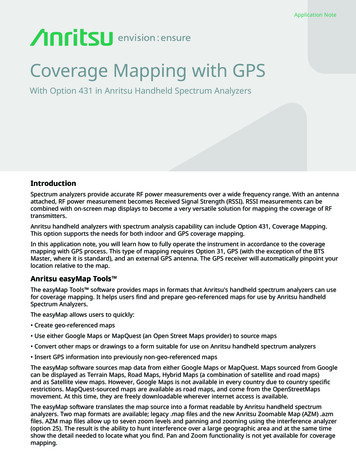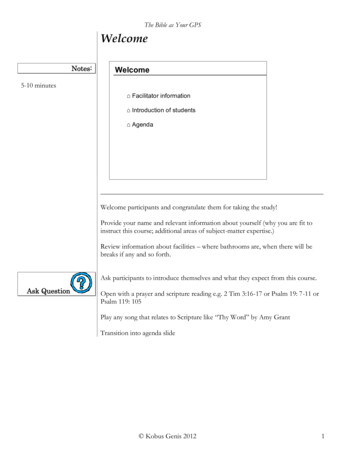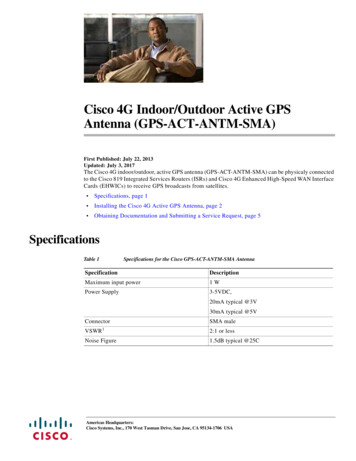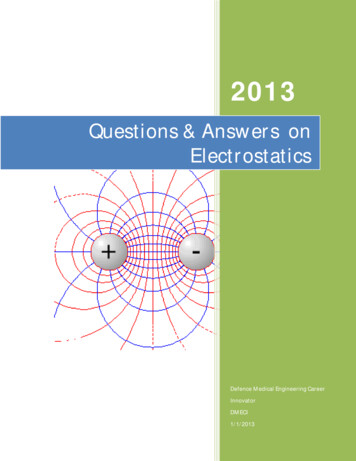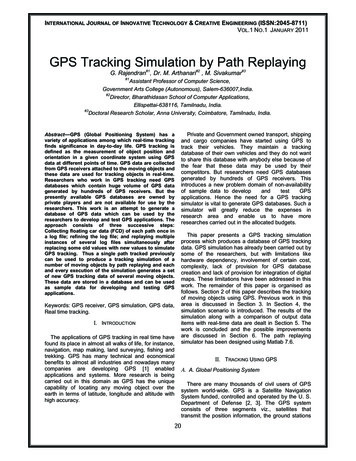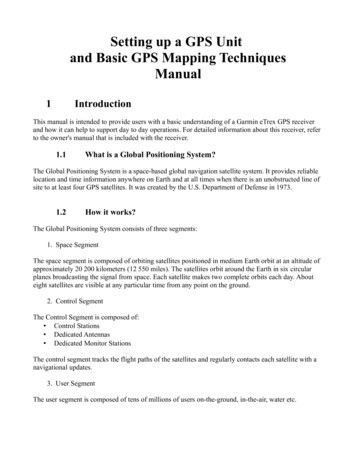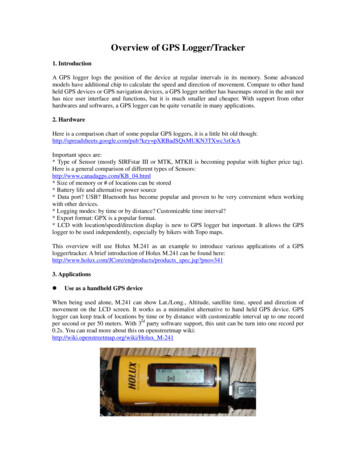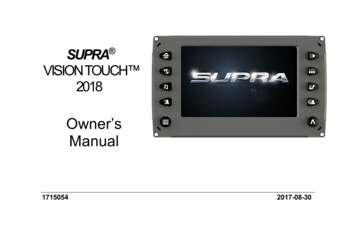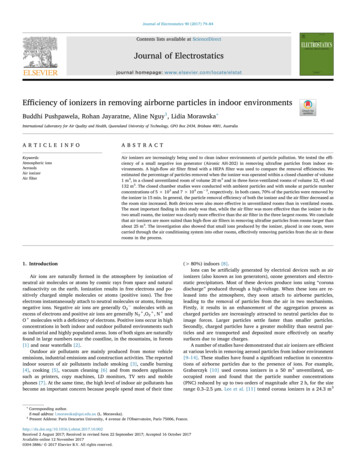
Transcription
Journal of Electrostatics 90 (2017) 79–84Contents lists available at ScienceDirectJournal of Electrostaticsjournal homepage: www.elsevier.com/locate/elstatEfficiency of ionizers in removing airborne particles in indoor environments1Buddhi Pushpawela, Rohan Jayaratne, Aline Nguy , Lidia MorawskaT International Laboratory for Air Quality and Health, Queensland University of Technology, GPO Box 2434, Brisbane 4001, AustraliaA R T I C L E I N F OA B S T R A C TKeywords:Atmospheric ionsAerosolsAir ionizerAir filterAir ionizers are increasingly being used to clean indoor environments of particle pollution. We tested the efficiency of a small negative ion generator (Aironic AH-202) in removing ultrafine particles from indoor environments. A high-flow air filter fitted with a HEPA filter was used to compare the removal efficiencies. Weestimated the percentage of particles removed when the ionizer was operated within a closed chamber of volume1 m3, in a closed unventilated room of volume 20 m3 and in three force-ventilated rooms of volume 32, 45 and132 m3. The closed chamber studies were conducted with ambient particles and with smoke at particle numberconcentrations of 5 103 and 7 104 cm 3, respectively. In both cases, 70% of the particles were removed bythe ionizer in 15 min. In general, the particle removal efficiency of both the ionizer and the air filter decreased asthe room size increased. Both devices were also more effective in unventilated rooms than in ventilated rooms.The most important finding in this study was that, while the air filter was more effective than the ionizer in thetwo small rooms, the ionizer was clearly more effective than the air filter in the three largest rooms. We concludethat air ionizers are more suited than high-flow air filters in removing ultrafine particles from rooms larger thanabout 25 m3. The investigation also showed that small ions produced by the ionizer, placed in one room, werecarried through the air conditioning system into other rooms, effectively removing particles from the air in theserooms in the process.1. IntroductionAir ions are naturally formed in the atmosphere by ionization ofneutral air molecules or atoms by cosmic rays from space and naturalradioactivity on the earth. Ionization results in free electrons and positively charged simple molecules or atoms (positive ions). The freeelectrons instantaneously attach to neutral molecules or atoms, formingnegative ions. Negative air ions are generally O2 molecules with anexcess of electrons and positive air ions are generally N2 ,O2 , N andO molecules with a deficiency of electrons. Positive ions occur in highconcentrations in both indoor and outdoor polluted environments suchas industrial and highly populated areas. Ions of both signs are naturallyfound in large numbers near the coastline, in the mountains, in forests[1] and near waterfalls [2].Outdoor air pollutants are mainly produced from motor vehicleemissions, industrial emissions and construction activities. The reportedindoor sources of air pollutants include smoking [3], candle burning[4], cooking [5], vacuum cleaning [6] and from modern appliancessuch as printers, copy machines, LD monitors, TV sets and mobilephones [7]. At the same time, the high level of indoor air pollutants hasbecome an important concern because people spend most of their time 1( 80%) indoors [8].Ions can be artificially generated by electrical devices such as airionizers (also known as ion generators), ozone generators and electrostatic precipitators. Most of these devices produce ions using “coronadischarge” produced through a high-voltage. When these ions are released into the atmosphere, they soon attach to airborne particles,leading to the removal of particles from the air in two mechanisms.Firstly, it results in an enhancement of the aggregation process ascharged particles are increasingly attracted to neutral particles due toimage forces. Larger particles settle faster than smaller particles.Secondly, charged particles have a greater mobility than neutral particles and are transported and deposited more effectively on nearbysurfaces due to image charges.A number of studies have demonstrated that air ionizers are efficientat various levels in removing aerosol particles from indoor environment[9–14]. These studies have found a significant reduction in concentrations of airborne particles due to the presence of ions. For example,Grabarczyk [10] used corona ionizers in a 50 m3 unventilated, unoccupied room and found that the particle number concentrations(PNC) reduced by up to two orders of magnitude after 2 h, for the sizerange 0.3–2.5 μm. Lee et al. [11] tested corona ionizers in a 24.3 m3Corresponding author.E-mail address: l.morawska@qut.edu.au (L. Morawska).Present Address: Paris Descartes University, 4 avenue de l’Observatoire, Paris 75006, 002Received 2 August 2017; Received in revised form 22 September 2017; Accepted 16 October 2017Available online 12 November 20170304-3886/ 2017 Elsevier B.V. All rights reserved.
Journal of Electrostatics 90 (2017) 79–84B. Pushpawela et al.chamber and found that particle removal efficiency was 97% for 0.1 μmparticles and 95% for 1 μm particles, after 30 min. Grinshpun et al. [12]tested commercially available ionic air cleaners in a 2.6 m3 chamberand found that the most powerful unit showed a particle removal efficiency of 90% within 5–6 min and 100% within 10–12 min for particlesizes between 0.3 and 3 μm. Both those studies concluded that theparticle removal efficiency was not significantly affected by the particlesize, while it increased with increasing ion emission rate. Wu et al. [13]studied the influence of the wall surface material on the removal ofparticles with negative air ions in an indoor environment. They useddifferent wall surface materials such as stainless steel, wood, polyvinylchloride (PVC), wallpaper and cement paint as the inner surface of achamber and concluded that the removal of particles from the air wasmore efficient when the walls were of wood and PVC than of any othermaterials. Further, Shiue et al. [14], studied particle removal efficiencyby measuring PNC at different heights and distances from the negativeion source in a closed chamber. They observed the highest particleremoval efficiency at a height of 60 cm from the floor. They also foundthat particle removal efficiency decreased with increase in distancefrom the negative ion source due to limited horizontal diffusion of ions.Sawant et al. [15] used corona discharge to test the possibility of reducing the concentration of fog and smoke in a 72 cm3 closed unventilated glass container. They found that a particle removal efficiencyof 93–97% in the chamber within 6 min. This study demonstrated thatit is possible to reduce the concentration of fog and smoke to a significant degree using negative air ions resulting in improved visibilityin a closed chamber.These studies clearly demonstrated that ionizers were efficient inreducing aerosol particles in indoor environments. However, most ofthese studies were conducted in closed chambers and not in real lifeenvironments. In this study, in addition to a closed chamber, we estimated the particle removal efficiency by a small negative ion generator(Aironic AH-202) in a number of different indoor environments such asunventilated and ventilated rooms, also investigating the effect of roomsize.2.1.4. Scanning mobility particle sizer (SMPS)A scanning mobility particle sizer (SMPS), consisting of a TSI 3936differential mobility analyser and a TSI 3781 condensation particlecounter, was used to determine the particle size distribution in therange 10–400 nm.2.2. Experimental methodsThe experiments were carried out in a range of different indoorenvironments at the Garden Point campus of the Queensland Universityof Technology in Brisbane. The indoor environments were chosen torepresent different volumes and ventilation systems. The experiments ineach environment were repeated three times.2.2.1. Chamber experimentsThese experiments were conducted with ambient air in a closedchamber of volume 1 m3. The initial PNC in the chamber was about5 103 cm 3. The P-track was placed at a height of 30 cm above thefloor while the ionizer was placed on the floor of the chamber with itspower switch accessible from outside to control its operation time. Ineach experiment, before the ionizer or the air filter was turned on, theconditions were allowed to reach an equilibrium state with the P-trakreadings steady for at least 5 min. At that time, the ionizer or the airfilter was turned on for a fixed period, as required, while the PNC wascontinuously monitored. Throughout this study, the air filter was usedin the high mode setting. Particle size distribution was measured by theSMPS, in order to determine any changes in particle size during theparticle charging process.In order to study the effect at high PNC values, the experiment wasrepeated with a controlled quantity of smoke introduced into thechamber by inserting a lighted match into the chamber for a very shorttime of less than 1 s. After a few minutes, this gave a mean PNC of about7 104 cm 3. The ionizer was turned on and left on for a period of25 min.2.2.2. Unventilated roomThese experiments were conducted in a closed unventilated room ofvolume 20 m3. The ionizer and P-trak were placed approximately 1.5 mapart. In each experiment, the ionizer or the air filter was turned onafter it was observed that the P-trak recorded an approximately constant PNC reading for 5 min. Next, the ionizer or the air filter wasturned on for a period of 15 min. When the ionizer or the air filter wasturned off, the P-trak continued recording for another 10–15 min. Airfilter was used in its high mode setting. The vertical distribution of PNCwas also investigated by placing the P-trak at different levels in theroom.2. Methods2.1. Instrumentation2.1.1. Ionizer (negative ion generator)A small commercially available negative ion generator (Aironic AH202) was used to ionize air molecules. This device is mains powered,contains four corona needles and emits approximately 1 106 negativeions s 1.2.1.2. Air filterAn air filter fitted with a HEPA filter, provided by Healthway (NewYork, USA) was tested in this study. The filter has three settings: highmode (air flow rate-5660 l/min), medium mode (air flow rate-3540 l/min) and low mode (air flow rate-2400 l/min). The estimated particleremoval efficiency by this device (based on the specifications reportedby the manufacturer) is 99.99% at of all particles as small as 0.007 μmin size.2.2.3. Ventilated roomsThese experiments were conducted in three ventilated rooms ofvolume 30 m3, 45 m3 and 130 m3. The ionizer or the air filter and the Ptrak particle monitor were placed at the same level, approximately1.5 m apart. In each experiment, after ensuring that the PNC wassteady, the ionizer or the air filter was turned on for a period of 15 min,after which, the P-trak continued recording for another 10–15 min. Theair filter was used at the high mode setting during all experiments. Theair flow rate through the ventilated rooms was approximately 30 l s 1.2.1.3. P-trak ultrafine particle number monitorA TSI model 8525 P-Trak ultrafine particle monitor was used tomeasure the number concentration of particles in the size range0.02–1 μm in real-time. The P-trak uses high-grade ethyl alcohol as itsworking liquid in the condensation particle counting technique to countultrafine particles by means of laser scattering and detection. Data isstored on the instrument and later downloaded to a computer using thesoftware provided. This instrument has a measurement range of0–500,000 particles per cm 3. The time resolution was set to 1 s.2.2.4. Ventilated systemA further set of experiments were conducted with the ionizer andthe P-trak particle counter in different rooms. The rooms were physically separated from each other but connected via the central air conditioner ventilation system. In this system, air was circulated through aHEPA filter and temperature control system and approximately 20% ofair from outside the building was filtered and mixed with the circulating air on each cycle. This meant that 80% of the air in the buildingwas being filtered and recirculated. The aim was to investigate if ions80
Journal of Electrostatics 90 (2017) 79–84B. Pushpawela et al.were able to penetrate through the HEPA filter and air conditioningsystem and be carried through from one room into another. In order todo this, the ionizer was placed in the large ventilated room of volume130 m3 and the P-track in each of the other two small ventilated roomsof volume 30 m3 and 45 m3. The initial PNC was recorded for 15 min inthe smaller room and then, the ionizer in the large ventilated room wasturned on for a period of 10 min while the measurements were continued.that the ionizer will preferentially cause smaller particles to be removed, thus increasing the average particle size.2.3.2. Percentage of particles removedThe percentage of particles removed was defined as the percentagedecrease in PNC with respect to the background count, of ionizer or airfilter in each indoor environment. It was calculated using the equationC Ct 100 %Percentage removed 0 C0 2.3. Analysiswhere C0 is the initial PNC (t 0) and Ct is the PNC at time t. C0 wasmeasured when the ionizer or air filter was turned off (ie. naturaldecay) and Ct was measured with the ionizer or air filter turned on. Wedefined the particle removal efficiency (εt) as the percentage of particlesremoved in a period of 15 min.2.3.1. TheoryWhen an ionizer is turned on, an electric field is created about thecorona needles of the ionizer, which ionizes the air in the room. Theseions can collide with water vapour molecules in the air, producing smallions. These small ions then attach to airborne particles.The deposition velocity of airborne particles due to gravitationalsettling can be expressed asvg gd 2ρ18η3. Results and discussionOver the course of the entire study, the room temperature rangedfrom 20–23 C, the relative humidity from 67–78% and the atmosphericpressure from 1005–1026 hPa. However, the maximum variation ofthese three parameters during the course of any given experiment wasof the order of 0.5 C, 1% and 1 hPa, respectively. Thus, the environmental conditions remained relatively stable over the course of eachexperiment.(1)where g is the gravitational constant, d is the particle diameter, ρ is thedensity of particle, and η is the viscosity of the air[16]. Here, we can seethat deposition velocity is proportional to the square of the particlediameter d. However, for the particles smaller than 1.0 μm, the equation (1) will be more accurate if it is multiplied by the slip correctionfactor Cc. Therefore, the slip-corrected form of the deposition velocitydue to gravitational settling can be expressed asvg gd 2ρCc18η3.1. Chamber experiments with ambient airFig. 1(a) shows the percentage of particles removed and the PNC asa function of time with the ionizer operating in the closed chamber. Theinitial PNC in the chamber was about 5000 cm-3. The ionizer wasturned on for a period of 10 min. The PNC dropped to approximately50% at the end of the first 5 min and by 70% at the end of the 10 minperiod of continuous operation. Thereafter, the PNC stabilized at about1500 cm-3. Fig. 1(b) shows the results of the experiment repeated withthe air filter at high flow, instead of the ionizer. In this case, almost 80%of the particles were removed within the first 30 s, and all of the particles in the chamber were removed in 2 min.Fig. 2 shows the typical particle number size distributions obtainedby the SMPS at three stages of these experiments - before, 10 min afterand 20 min after the ionizer was turned on. The background concentration did not change by more than about 10% in the course of timewhen the ionizer was not activated. It can be seen that the ionizer wasefficient at removing particles in the entire size range 10–400 nm. Thisis in contradiction to Grabarczyk [10] who reported that only particleslarger than 0.3 μm could be efficiently removed by corona ionizers.Although it is not obvious in Fig. 2, we found that the count mediandiameter (CMD) of the particle size distributions increased significantlywhen the ionizer was turned on. From an initial CMD of 76 nm, it increased to 87 nm at the end of the 10 min period of operation. This is aresult of two physical processes that cannot be experimentally separated. First, smaller charged particles have a higher mobility than largercharged particles, and therefore, they migrate towards and are deposited on the walls of the chamber more effectively than the largerparticles. Secondly, particles attach to charged particles more readilythan to neutral particles. Operating the ionizer results in more chargedparticles and enhanced coagulation, thus increasing the CMD of theparticles.(2)The drift velocity of charged particles is given byve μE nqECc3πηd(3)where μ is the particle mobility, n is the number of charge, q is charge ofan electron, E is the intensity of the electric field, η is the viscosity of theair and d is the particle diameter [16]. The slip correction factor, Cc is inthe form ofCc 1 λ λ2.34 1.05 exp 0.39 d d (4)where λ is the mean free path in the air and d is the particle diameter[16]. Here, we can see that drift velocity is inversely proportional toparticle diameter d. That is, smaller particles will experience higherspeeds.Further, the maximal drift velocity of the particle is approximatelyequal to2λ3εr 1 d ve μE E 2ε0 d2 εr 3η (5)where μ is the mobility of the particle, E is the intensity of the electricfield, ε0 is the permittivity of the air, εr is the relative permittivity of theparticle [10].When ve vg, the mechanism of the removal of particles fromthe air is dominated by electrical forces rather than by gravitationalsettling. Using equations (2) and (5), this condition givesE 2 εr gdp 3εr 6ε0 3.2. Chamber experiments with smoke (6)This expression shows that the electric field E required to removeparticles increases in proportion to the square root of the diameter ofthe particles. Smaller particles have a higher electrical mobility and aremore likely to meet the condition for removal. Therefore, it is expectedWhile the above study shows how particles in the air are removedby an ionizer and a commercial air filter, an interesting aspect of thestudy was to investigate the efficiency of these two devices in a highPNC environment. This was achieved by injecting a controlled amount81
Journal of Electrostatics 90 (2017) 79–84B. Pushpawela et al.Fig. 3. Percentage of smoke particles removed by the ionizer (in blue) and PNC (inpurple) in the closed chamber. The ionizer was turned on at time 5 min and off at 30 minas indicated by the two broken lines. (For interpretation of the references to colour in thisfigure legend, the reader is referred to the web version of this article.)the smoke, the initial PNC was about 7 104 cm-3. When the ionizerwas turned on, the PNC began to decrease slowly. After a period ofabout 25 min, the concentration reached a steady value of about1.3 104 cm-3. The particle removal efficiency was highest soon afterthe ionizer was turned on and then decreased in time. The high numberof ions emitted in the relatively small volume removed a considerablenumber of airborne particles by the same two mechanisms described inthe previous section. 20% of the smoke particles were removed in thefirst 5 min, and 80% within a period of about 20 min.3.3. Unventilated roomFig. 1. Percentage of particles removed in the closed chamber using (a) the ionizer (b) theair filter (in blue) and PNC (in purple). In (a), the ionizer was turned on at 5 min and off at15 min as shown by the two broken lines. In (b), the air filter was turned on at 5 min andoff at 7 min as shown by the two broken lines. (For interpretation of the references tocolour in this figure legend, the reader is referred to the web version of this article.)The experiments in the unventilated room demonstrated that theionizer caused a vertical PNC gradient. At the same level as the ionizer,the PNC decreased from 2700 cm-3 to 1750 cm-3 (removed 35% ofparticles) in 5 min and to 1500 cm-3 (removed 45% of particles) after15 min. At a level 1 m above that of the ionizer, the PNC decreased from2700 cm-3 to 2400 cm-3 (removed 11% of particles) in 5 min and to2000 cm-3 (removed 25% of particles) after 10 min. This behaviour is inagreement with the findings of Shiue et al. [14] and indicated that theposition of the ionizer is an important factor in particle removal.When the air filter was turned on at its high mode setting, the PNCin the room decreased from 6500 cm-3 to 3200 cm-3 (removed 50% ofparticles) in 5 min and from to 2500 cm-3 (removed 60% of particles)after 15 min. These results show that, with the filter turned on, theparticle removal efficiency with the air filter was significantly higherthan that with the ionizer in the closed unventilated room. Fig. 4 showsthe corresponding percentages of particles as a function of time for theair filter, and the ionizer, at the same vertical level.3.4. Ventilated roomsAs expected, with the ionizer turned on, the particle removal efficiencies in the ventilated rooms were lower than that in the unventilated room. The mean percentages of particles removed in a periodof 15 min in the small ventilated room, medium ventilated room andthe large ventilated room were 40%, 30% and 22% respectively (Fig. 5).The removal efficiency with the air filter was also tested in the samerooms. The mean percentages of particles removed by the air filter in15 min in the small ventilated room, medium ventilated room and thelarge ventilated room were 25%, 10% and 6% respectively (Fig. 5).These values are all smaller than the corresponding values observed inthe small unventilated room. However, an interesting observation isFig. 2. Typical size distribution before the ionizer was turned on (in blue), 10 min after itwas turned on (in red) and 20 min after it was turned on (in green). Initial PNC 5000cm-3. (For interpretation of the references to colour in this figure legend, the reader isreferred to the web version of this article.)of smoke into the chamber. Fig. 3 shows the percentage of particlesremoved and the PNC as a function of time with the ionizer operating inthe closed chamber after the introduction of smoke. After introducing82
Journal of Electrostatics 90 (2017) 79–84B. Pushpawela et al.Fig. 4. Percentage of particles removed in a small unventilated room using the ionizer (inblue) and the air filter (in red). In each experiment, the device was turned on at time5 min and off at 20 min as indicated by the two broken lines. (For interpretation of thereferences to colour in this figure legend, the reader is referred to the web version of thisarticle.)that, in the larger ventilated rooms, the removal efficiency with theionizer was clearly greater than with the high-flow air filter unit. Todemonstrate this, in each room, we calculated the mean removal efficiency in the first 15 min after the ionizer or air filter was turned on.Fig. 6 shows the result. It was observed that, considering the uncertainties involved, while the air filter was significantly more efficientthan the ionizer in the chamber and in the small room (to the left of thebroken line), the ionizer was clearly more efficient than the air filter inthe three larger rooms (to the right of the broken line). The thresholdsize of room is about 25 m3 but this value is obviously specific to theionizer used and air filter used in this study. In order to explain thisobservation, we hypothesize that, while the air filter loses some efficiency because it recycles the cleaned air from its proximity and doesnot access the peripherals of the room, the ions from the ionizer scatterthroughout the room and is able to charge and remove a larger numberof particles from the room. This effect will not be dominant in smallrooms but will be more effective as the room size becomes larger.3.5. Ventilated systemsAll of the above experiments were conducted within a given space,either a chamber or a room. The last part of this study was designed toinvestigate whether ions produced in one room could be carried by theair conditioning system into other rooms and affect the PNCs in thoserooms. When the ionizer was turned on for 10 min in the large ventilated room, the PNC was significantly decreased in both smaller rooms.The removal efficiencies in the two rooms were in the range 30–40%,which is of the same order as when the ionizer was in the same room.This is an interesting finding and shows that the ions are carried between rooms through the air conditioning system. No doubt, particles inthe air conditioning unit are removed by the ions and the air that isexpelled into the rooms have a lower PNC than when there was noionizer in the other room. While the larger particles are trapped in theHEPA filters in the air conditioning unit, small ions are able to passthrough the HEPA filters and reach other rooms. The air exchange ratecould have an impact on the performance of removing particles inventilated systems.Fig. 5. Percentage of particles removed in three ventilated rooms of volumes (a) 32 m3(b) 45 m3 (c) 132 m3 using the ionizer (in blue) and the air filter (in red) separately. Eachof the devices were turned on at 5 min and off at 20 min as indicated by the two brokenlines. (For interpretation of the references to colour in this figure legend, the reader isreferred to the web version of this article.)further information pertaining to room size and ventilation systems.With the ionizer used in this study, the particle removal efficienciesranged from 70% in a small chamber (1 m3) to 20% in a large room(130 m3). The removal efficiencies in each of the rooms were comparedwith that due to a high-flow (5660 l min-1) HEPA filter. While theparticle removal efficiency was higher with the ionizer than with thefilter in the chamber and the small room, the ionizer was more efficientat removing particles from the air in the three larger rooms (larger than25 m3). It was observed that the ionizer removed, not just the largeparticles but, ultrafine particles too of all sizes. When the ionizer was4. ConclusionsWhile confirming that air ionizers are able to remove ultrafineparticles from indoor environments, the results of this study provide83
Journal of Electrostatics 90 (2017) 79–84B. Pushpawela et al.nature of emission and dispersion, J. Electrost. 69 (2011) 228–235.[2] P. Kolarz, M. Gaisberger, P. Madl, W. Hofmann, M. Ritter, A. Hartl, Characterizationof ions at Alpine waterfalls, Atmos. Chem. Phys. 12 (2012) 3687.[3] N. Jones, C. Thornton, D. Mark, R. Harrison, Indoor/outdoor relationships of particulate matter in domestic homes with roadside, urban and rural locations, Atmos.Environ. 34 (2000) 2603–2612.[4] U. Matson, Indoor and outdoor concentrations of ultrafine particles in someScandinavian rural and urban areas, Sci. Total Environ. 343 (2005) 169–176.[5] C.Y. Chao, T.C. Tung, J. Burnett, Influence of different indoor activities on the indoor particulate levels in residential buildings, Indoor Built Environ. 7 (1998)110–121.[6] C. Clayton, R. Perritt, E. Pellizzari, K. Thomas, R. Whitmore, L. Wallace,H. Ozkaynak, J. Spengler, Particle Total Exposure Assessment Methodology(PTEAM) study: distributions of aerosol and elemental concentrations in personal,indoor, and outdoor air samples in a southern California community, J. Expo.analysis Environ. Epidemiol. 3 (1993) 227–250.[7] J. Černecký, K. Valentová, E. Pivarčiová, P. Božek, Ionization impact on the aircleaning efficiency in the interior, Meas. Sci. Rev. 15 (2015) 156–166.[8] P.L. Jenkins, T.J. Phillips, E.J. Mulberg, S.P. Hui, Activity patterns of Californians:use of and proximity to indoor pollutant sources, Atmos. Environ. Part A. GeneralTop. 26 (1992) 2141–2148.[9] S. Grinshpun, G. Mainelis, T. Reponen, K. Willeke, M. Trunov, A. Adhikari, Effect ofwearable ionizers on the concentration of respirable airborne particles and microorganisms, J. Aerosol Sci. 32 (2001) S335–S336.[10] Z. Grabarczyk, Effectiveness of indoor air cleaning with corona ionizers, J.Electrost. 51 (2001) 278–283.[11] B.U. Lee, M. Yermakov, S.A. Grinshpun, Removal of fine and ultrafine particles fromindoor air environments by the unipolar ion emission, Atmos. Environ. 38 (2004)4815–4823.[12] S. Grinshpun, G. Mainelis, M. Trunov, A. Adhikari, T. Reponen, K. Willeke,Evaluation of ionic air purifiers for reducing aerosol exposure in confined indoorspaces, Indoor air 15 (2005) 235–245.[13] C.C. Wu, G.W. Lee, P. Cheng, S. Yang, K.P. Yu, Effect of wall surface materials ondeposition of particles with the aid of negative air ions, J. Aerosol Sci. 37 (2006)616–630.[14] A. Shiue, S.-C. Hu, M.-L. Tu, Particles removal by negative ionic air purifier incleanroom, Aerosol Air Qual. Resarch 11 (2011) 179–186.[15] V. Sawant, G. Meena, D. Jadhav, Effect of negative air ions on fog and smoke, Inter.J. Aerosol Air Qual. Res. 12 (2012) 1007–1015.[16] W.C. Hinds, Aerosol Technology: Properties, Behavior, and Measurement ofAirborne Particles, John Wiley & Sons, 2012.Fig. 6. The mean particle removal efficiencies due to the ionizer (in blue) and air filter (inred) as a function of room size. The uncertainties in the values ranged from 10% in thesmallest room to 5% in the largest room. (For interpretation of the references to colour inthis figure legend, the reader is referred to the web version of this article.)placed in one room, the air conditioning system carried small ions intoother rooms and was consequently effective in removing a significantnumber of airborne particles in these other rooms.FundingThis research did not receive any specific grant from fundingagencies in the public, commercial, or not-for-profit sectors.References[1] E. Jayaratne, X. Ling, L. Morawska, Corona ions from high-voltage
and found that the most powerful unit showed a particle removal ef-ficiency of 90% within 5-6 min and 100% within 10-12 min for particle sizes between 0.3 and 3 μm. Both those studies concluded that the particle removal efficiency was not significantly affected by the particle size, while it increased with increasing ion emission rate.
